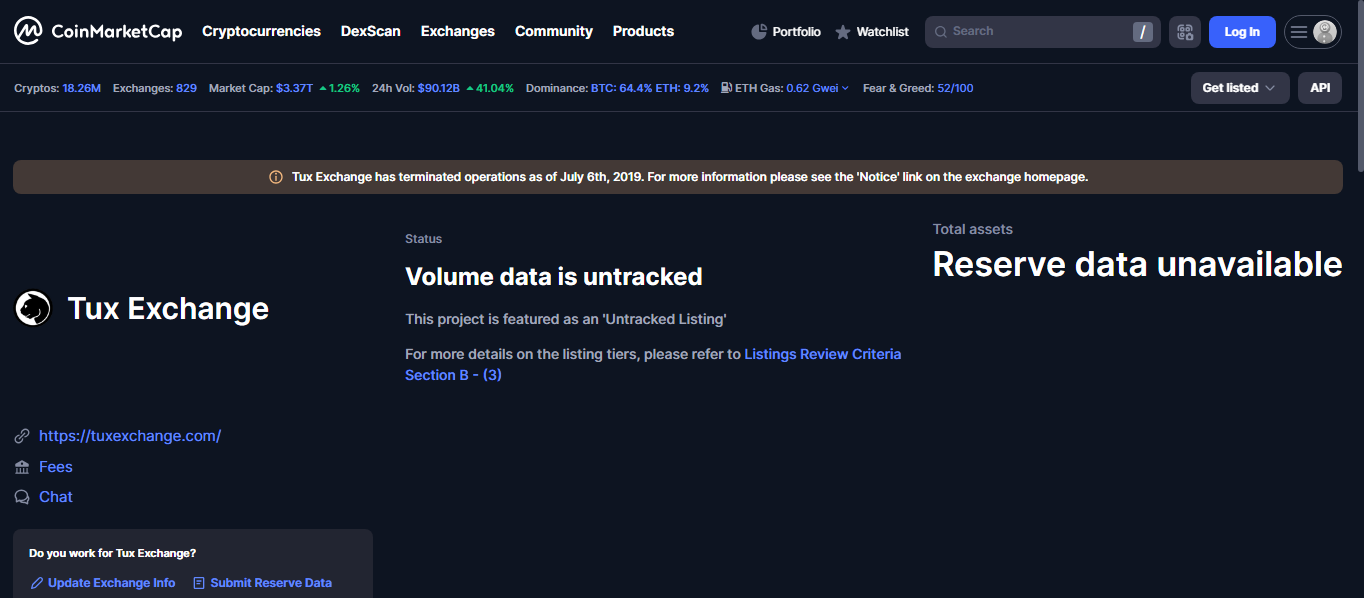Tux Exchange Review - Dormant Platform or Niche Spot Venue?

Tux Exchange was a Canadian crypto platform focused on spot trading since around 2016-2019. It offered a clean interface and no maker fees, but it shut down operations in July 2019 and is now inactive. Here's a detailed snapshot and assessment.
Snapshot table
What happened to Tux Exchange
Tux Exchange abruptly ceased operations in July 2019, citing “unfavourable regulatory conditions” as the reason for shutting down. This closure means that even if you still have an account, you won’t be able to trade, withdraw, or deposit.
At the time, it positioned itself as a simple, privacy-friendly platform focusing on lesser-known tokens. It did allow limit orders and basic trading pairs, but without deeper features like margin or fiat gateways.
Pros & cons
Pros
- Maker fee at zero encourages limit order usage
- Withdrawal fee for BTC was low at 0.0007 BTC
- Clean, easy web interface with basic charting and order support
Cons
- Now inactive - no access to funds or markets
- No fiat rails - crypto deposits only
- No transparency - no audits, proof of reserves, or regulatory compliance
- Limited coin support with thin liquidity even when active
- Trust ratings are poor - marked inactive and flagged with security risk reports
Trading experience back then
When Tux was active, it managed a taker fee of 0.3 % with zero maker fee to attract liquidity providers. The platform listed around 16-17 cryptos - Bitcoin, Dogecoin, Monero, Peercoin, Zcash, DASH and similar mid-cap tokens.
There were no fiat deposits or withdrawals, so users had to transfer crypto in. Limit orders were supported, but advanced features like margin trading, stop orders or derivatives were not available. The exchange interface included order books, trading chart, buy-sell boxes and basic customization for charts.
Security and trustworthiness
Tux claimed basic security tools - two-factor authentication, cold storage, SSL protection and login alerts. But no external audits, proof-of-reserves or insurance covered deposits. That lack of transparency, combined with its shutdown, makes it a poor choice today.
WikiBit and other aggregators have flagged it as “stopped business” with “no valid regulation”. Security auditors gave it a D-grade due to the absence of oversight. Trustpilot and user review platforms show low scores and inconsistent support.
Who might still care
Practically no one today - Tux Exchange is dormant. The only remaining interest could be former users looking to recover old balances (which is unlikely). Otherwise, there are far superior active alternatives for spot trading, especially for altcoin access.
Final take
Tux Exchange once served as a simple, no-frills spot venue with no maker fee and a handful of low-cap coins. That changed abruptly in July 2019 when it shut down due to regulatory pressures. Today it’s inactive, unregulated, insecure and inaccessible.
Use it only if you’re attempting to recover past account assets - and even then proceed with caution. For any actual trading, choose active, transparent and regulated platforms with modern features, audit trails and support.
Disclaimer
“This content is for informational purposes only and does not constitute financial advice. Please do your own research before investing.”
.png)







%203.svg)
%203.svg)




















